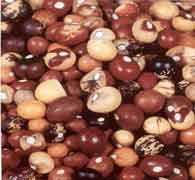This is the VOA Special English Agriculture Report.
Farmers may not be able to prevent natural disasters, but they can at least try their best to reduce losses.
For example, they can plant crops that are more likely to survive extreme weather. In north-central Vietnam, people with small farms do not plant rice between September and December. Seasonal rains might destroy the rice. So instead, they plant lotus seeds on raised beds. The United Nations Food and Agriculture Organization says the lotus seeds bring a good price in local markets.
Farmers in the Philippines are showing new interest in crops like winged beans, string beans, arrowroot and cassava. The Asian Disaster Preparedness Center says traditional crops like these can survive the fierce storms that often strike the islands.

The United Nations says some African farmers grow bambara groundnuts during long dry periods. The seeds of this drought-resistant plant can be boiled for eating or for making flour.
In some parts of the world, farmers grow vetiver grass. Researchers in Thailand wrote about vetiver in 2007 in the journal ScienceAsia. They noted that the grass can absorb and control the spread of harmful wastewaters, like those from pig farms.
Agricultural expert and author William Rivera says vetiver resists difficult conditions. It reduces damage from heavy rains. And vetiver planted on earthen dams may strengthen them against breaks and flooding.
William Rivera also speaks approvingly of alfala. Its deep roots can find and take up groundwater. Those roots also help hold the soil against winds. And alfalfa can be a valuable food source for animals.
The deep and extensive roots of sunflowers make them another good candidate for resisting extreme conditions. The tall plants have brightly colored heads that provide seeds and oil.
North Dakota grows more hectares of sunflowers than any other American state. But North Dakota is better known as a top wheat producing state.
Hans Kandel works at the North Dakota State University Extension Service in Fargo. He says farmers in some parts of North Dakota plant wheat that is ready to harvest in only about 100 days. That way it can grow before the hot, dry months of July through September.
And that's the VOA Special English Agriculture Report, written by Jerilyn Watson. You can find captioned videos of our reports along with transcripts and MP3s at voaspecialenglish.com. You can also post questions and comments. I'm Jim Tedder.
lotus: a tropical plant with white or pink flowers that grows on the surface of lakes in Africa and Asia 蓮屬植物
winged bean: a tuberous twining annual vine bearing clusters of purplish flowers and pods with four jagged wings 四角豆
string bean: long, very narrow green vegetable consisting of the cases that contain the seeds of a climbing plant 四季豆
arrowroot: a powder which is prepared from the root of an American plant and used in cooking, especially to make sauces thick 竹芋粉(竹芋根制成,用于烹調(diào))
cassava: a type of flour made from the thick roots of a tropical plant 木薯粉
bambara groundnut: 班巴拉花生
vetiver: a grass of tropical India, cultivated for its aromatic roots that yield an oil used in perfumery (印度產(chǎn)的)香根草
alfala: 苜蓿
Mapping the way to a better soybean
New understanding of how plants use water
Keeping plants and trees warm when temperatures drop
New alliance to study greenhouse gases in agriculture
(來源:VOA 編輯:陳丹妮)
